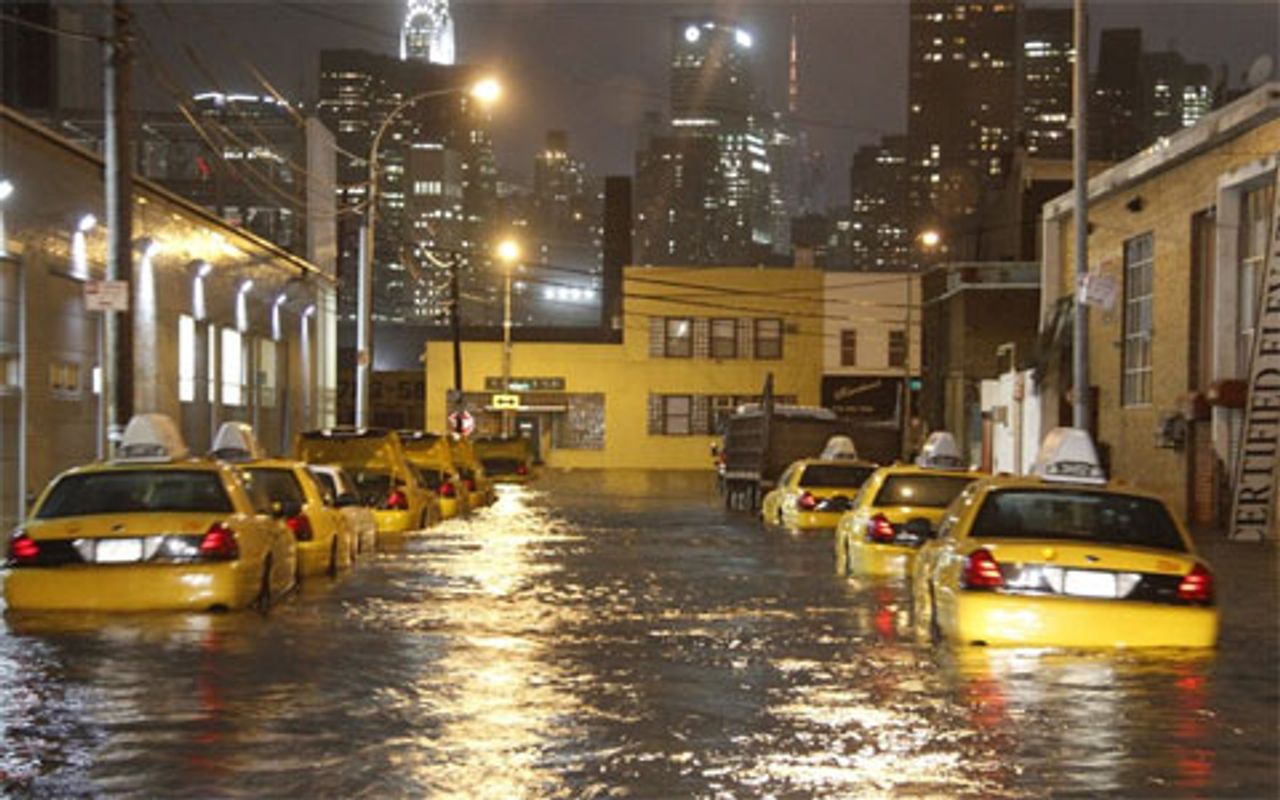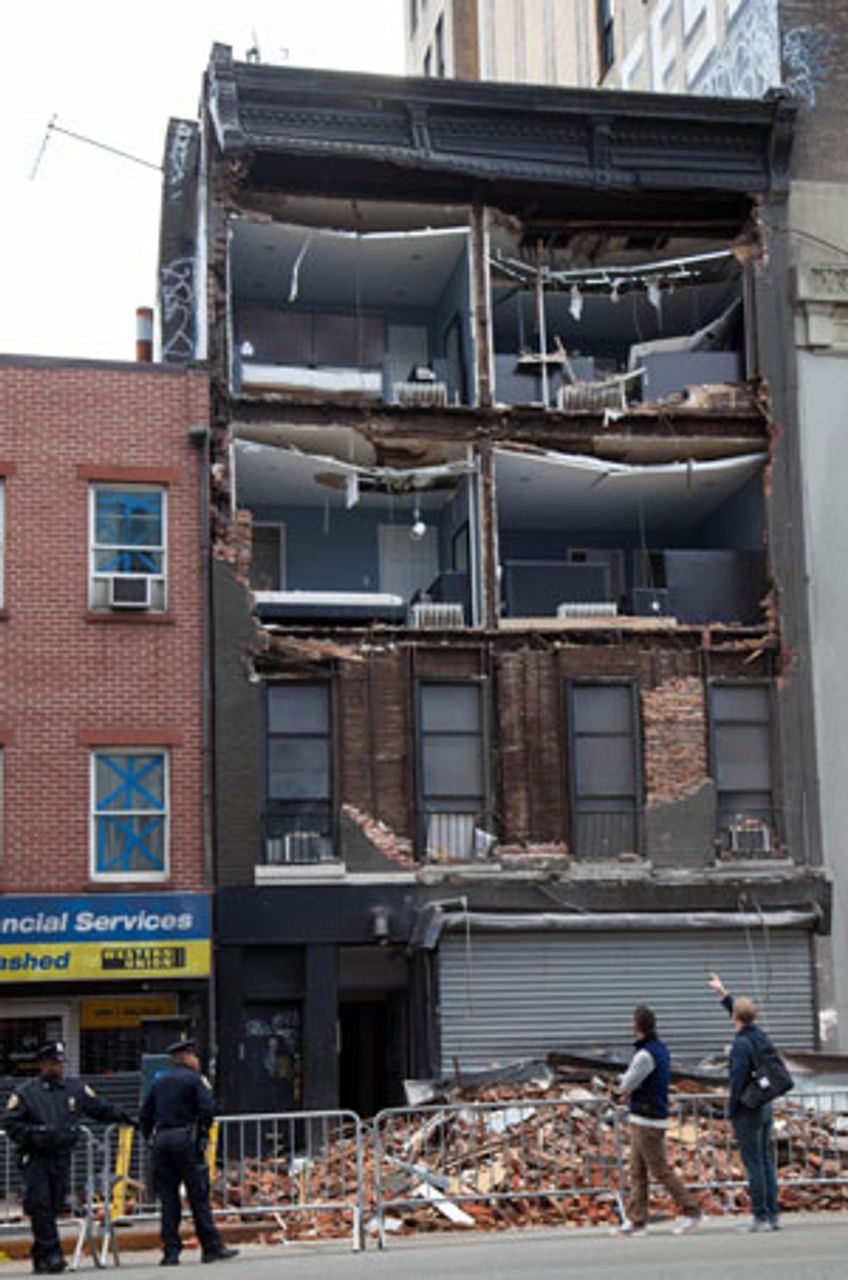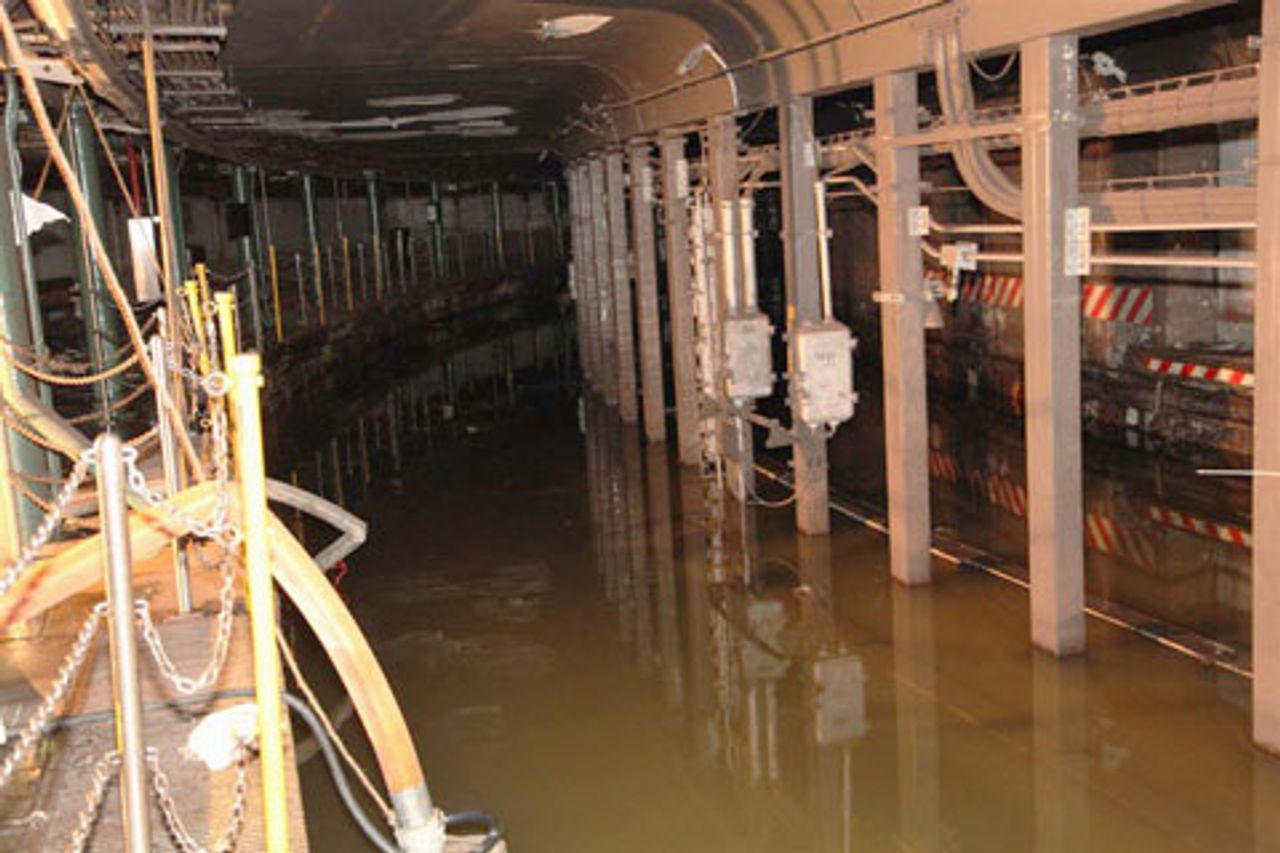 Taxis stranded on a Hoboken, New Jersey street
Taxis stranded on a Hoboken, New Jersey street[Photo: Flickr user ThatHartfordGuy]
Two days after Hurricane Sandy’s landfall in southern New Jersey, the scope and severity of this storm continues to be counted in deaths and unprecedented destruction spreading from the coastal states of the northeast U.S. to Appalachia and the shores of the Great Lakes in the Midwest.
As of noon on Wednesday, 6.2 million homes were still without power, a toll that had fallen slightly from the record 8.5 million a day earlier. The death toll had risen to 64, and may rise further as the cleanup efforts continue. In New York City, the hardest hit population center, the subways remained shut down and the entire southern half of Manhattan remained without power.
 An apartment building in Manhattan
An apartment building in Manhattan[Photo: Kate Gardiner]
Of the death toll, nearly half were from New York State, with 22 from New York City. There were countless narrow escapes, including families rescued from rooftops in the New York borough of Staten Island as well as from Hoboken, New Jersey, just across the Hudson River from Manhattan. Earlier, there were 69 reported deaths in the Caribbean as a result of the hurricane.
One of the most dramatic scenes of devastation was that in Breezy Point, the community on the western edge of the Rockaway Peninsula in Queens. Some 111 homes were destroyed and another 20 heavily damaged in a blaze that was spread rapidly by gale-force winds and where flooded streets made it virtually impossible for firefighters to approach the inferno. There were no deaths or serious injuries in the neighborhood, on the Atlantic Ocean and surrounded by water, since the vast majority of residents had evacuated earlier.
The New York City business district came back to life only slowly on October 31, with the absence of subways leading to overcrowded buses and traffic gridlock. The New York Stock Exchange opened after a two-day interruption, but the lower Manhattan financial district was otherwise barely functioning. The iconic East and West Village neighborhoods remained without power, and the annual Halloween Day Parade, an event that has grown massively since it originated 39 years ago, was canceled for the first time. The area of the power outage included the headquarters of both Verizon and Con Edison, the main telecom and power companies.
 The South Ferry station platform in lower Manhattan [Photo: MTA Patrick Cashin]
The South Ferry station platform in lower Manhattan [Photo: MTA Patrick Cashin]By midday Wednesday the Metropolitan Transportation Authority finally announced the resumption of limited subway service on the following day. The agency said there would be no service south of the midtown subway stations at 34th and 42nd Streets and urged commuters to allow at least one extra hour commuting time. With most subway tunnels connecting the city’s boroughs still flooded, buses were promised to take passengers from Queens and Brooklyn across the East River into Manhattan.
The unprecedented flooding of the subway system, the greatest crisis it has faced in its 108-year history, was the direct result of storm surges that reached a level of 14 feet, nearly three feet higher than originally predicted and almost four feet higher than the previous record.
Commuter rail service on the Long Island Rail Road and the Metro North Railroad remained suspended. Newark and Kennedy International airports resumed only limited service, with LaGuardia Airport remaining closed “because of extensive damage,” according to New York Governor Andrew Cuomo.
Meanwhile, no definite date was given for the resumption of electricity to lower Manhattan, although it was not expected before the weekend at the earliest. On Long Island, east of the city, 90 percent of households remained without power. 2.7 million customers were without power in New Jersey, and half of the gas stations in that state and in Long Island remained closed because supplies of gas were delayed by the storm and its aftermath.
At the height of the storm on Monday night, the backup generator at New York University Medical Center failed and 300 patients were evacuated. By Wednesday it was reported that Bellevue Medical Center, the city’s best known public hospital, was facing evacuation because the continued loss of power had begun to endanger patient care.
The highly unusual path of the storm meant that the states of West Virginia, Ohio and Pennsylvania were affected, although not as severely as New York, New Jersey and Connecticut. About 265,000 residents of West Virginia were without power as of Tuesday, and the outage was expected to last for days. The governor declared a state of emergency, while parts of the state in higher elevations soon reported snow accumulations of up to two feet.
The effects of Hurricane Sandy were felt as far as the shores of Lake Michigan in Chicago, where wind gusts of 60 miles per hour and waves of 20 feet were reported. There were warnings of possible flooding on Lake Erie, Lake Huron and Lake Michigan.
New Jersey was perhaps the most devastated of all the states hit by the storm, and certainly the state with the highest percentage of both area and population affected. After making landfall, the hurricane wreaked devastation far inland, with many towns in the northern part of the state dangerously flooded after the storm surge washed over the New Jersey Turnpike.
This was the immediate backdrop for the visit by President Barack Obama to the state on Wednesday afternoon. Obama was welcomed by the Republican Governor of New Jersey, Chris Christie. Governor Christie, a right-wing backer of the presidential candidacy of Mitt Romney who gave the keynote speech at the Republican National Convention, has gone out of his way since the hurricane hit on Monday to lavish praise on the White House and on Obama in particular for the president’s “cooperation” in the face of the storm.
This spectacle of the Democratic president and a leading Republican backer of his challenger patting each other on the back underscores the bipartisan consensus that underlies the current contest for the presidency. The name calling and election demagogy are primarily designed to confuse the population while mobilizing rival elements of the ruling elite and the upper middle class, but both parties are united in defense of big business and austerity policies.
Christie, Obama and Romney all preside over and are responsible for the devastation facing millions of working people, and for the devastation caused by Hurricane Sandy in particular. As with Katrina and other natural disasters, the suffering will be compounded by the class war policies followed by both parties, as families are left to fend for themselves, while insurance companies refuse to pay benefits and corporate and political officials escape any accountability.
